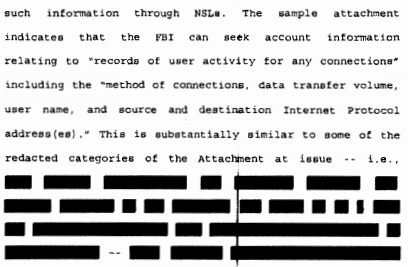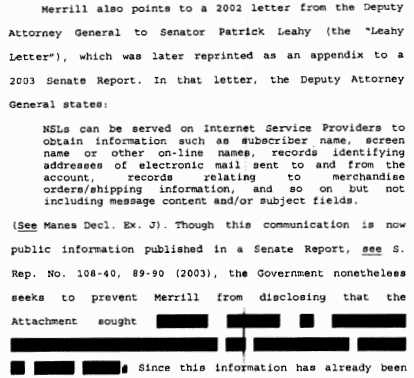FBI Redacted Passages Showing Judge Mocking Its Stupid Claims
As I noted earlier, today Nicholas Merrill was finally able to reveal the things he was requested to turn over to the FBI in response to a National Security Letter he received 11 years ago.
The expiration of his gag order also allowed him to publish an unredacted copy of the ruling ending the gag, which was released in redacted form in September. Comparing the two lets us see what the government believed had to be redacted in September. Not only does it show how ridiculous were FBI’s claims of secrecy, but also makes it clear FBI used such claims to hide the fact that the judge in the case, Victor Marrero, was mocking the stupidity of its claims.
The most important new disclosure is that the FBI no longer uses NSLs to get location information and that it considered location information to be included among log files. (In all passages, I have underlined what the government originally redacted.)
Additionally, the Government seeks to keep some information redacted despite publicly conceding that those types of records (i.e., “radius log” information, which is cell-tower based phone tracking information) are no longer sought through NSLs. Yet the Government still argues that this information should remain redacted because it would reveal techniques that might be used at some undetermined time under a hypothetical policy promulgated by a future administration.
More stunning is that the government wanted to hide that it can obtain daytime and evening phone numbers with one NSL.
For example, the Government seeks to prevent Merrill from disclosing that the Attachment requested “Subscriber day/evening telephone numbers” even though the Government now concedes that the phrase “telephone number” can be disclosed. The Court is not persuaded that there is a “good reason” to believe that disclosure of the fact that the Government can use NSLs to seek both day and evening telephone numbers could result in an enumerated harm, especially if it is already publicly known that the Government can use NSLs to obtain a telephone number, more generally.
By golly if the terrorists realize the FBI knows some people have separate work numbers, they’re sure to win!
Demands like this clearly tanked the government’s credibility with Judge Marrero, because he kicked their ass about the absurdity of some claims, such as their attempt to redact the “s” indicating that the FBI would ask for telephone numbers, plural.
As another example of the extreme and overly broad character of these redactions, the Government apparently believes that while the public can know that it seeks records of an “address” and a “telephone number,” there is a “good reason” to prevent disclosure of the fact that the Government can seek “addresses” and “telephone numbers.” (See Gov’t Mem. Attach.) In any event, based on the Government’s redactions alone, a potential target of an investigation, even a dim-witted one, would almost certainly be able to determine, simply by running through the alphabet, that “telephone numberll” could only be “telephone numbers.” Redactions that defy common sense such as concealing a single letter at the end of a word diminish the force of the Government’s claim to “good reason” to keep information under seal, and undermine its argument that disclosure of the currently-redacted information in the Attachment can be linked to a substantial risk of an enumerated harm.
Marrero then reminded the FBI that they had claimed they were chasing “sophisticated foreign adversaries,” not dim-witted terrorists.
Therefore, it strains credulity that future targets of other investigations would change their behavior in light of the currently-redacted information, when those targets (which, according to the Government, include “sophisticated foreign adversaries,” see Perdue Deel. ~ 56) have access to much of this same information from other government divisions and agencies.
And he revealed that their declarant was demanding things they had already disclosed be kept secret.
10 Also interestingly, the Perdue Declaration argues that the category of “[a] ny other information which [the recipient] consider [s] to be an electronic communication transactional record” should not be disclosed. (See Perdue Deel. , 70.) However, this category was not redacted by the Government in its submissions or even in the Perdue Declaration.
Here’s the thing though: the last two of these redactions were not hiding secret information at all. Instead, they (plus the phone number comments, though technically those included top secret information about the FBI obtaining telephone numbers, plural) served to hide the fact that Marrero was making fun of the FBI’s batshit claims.
Opinions may vary about whether the FBI’s 11-year fight to hide the fact it knows some people have work phone numbers was an appropriate use of secrecy. But hiding that a judge is mocking your stupid claims doesn’t fit under any legal use of classification. It’s abuse, pure and simple.


